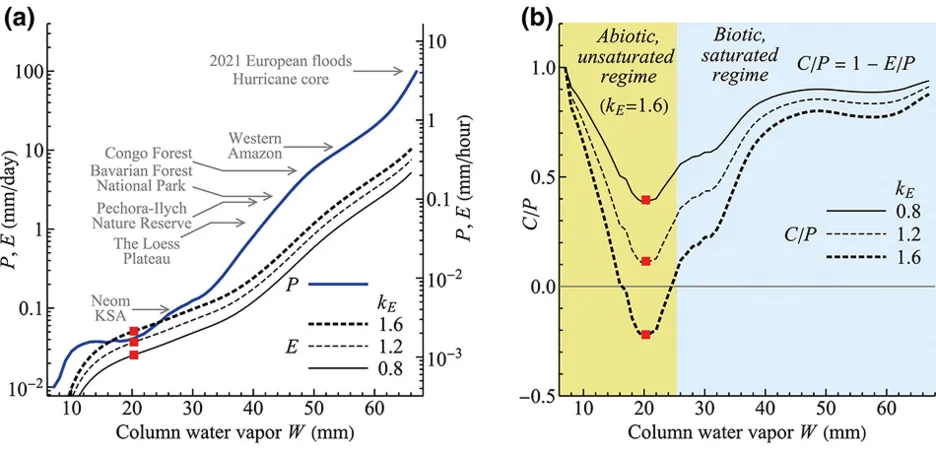Quantifying how natural ecosystems stabilize the water cycle
How ecosystem restoration affects the water cycle, particularly river runoff and atmospheric moisture convergence, is an important and controversial issue in environmental science. We show that ecosystem effects can depend on air humidity. Under wet (dry) conditions, additional transpiration increases (decreases) river runoff, indicating a vegetation-related tipping point in atmospheric dynamics.

Focus Group: Group: Drought Mitigation Through Ecosystem Restoration: Challenges and Opportunities
Dr. Anastassia Makarieva (Petersburg Nuclear Physics Institute), Alumna Anna Boyksen Fellow (funded as part of the Excellence Strategy of the federal and state governments) | Host: Prof. Anja Rammig (TUM)
The project was implemented within the framework of the biotic pump concept, which states that by moistening the atmosphere, forest transpiration creates conditions that facilitate the transport of atmospheric moisture from the ocean to land. At steady state, the atmospheric moisture convergence (net import) equals the river runoff (net export) of liquid water from an ecosystem. While the biotic pump concept predicts increased river runoff with increased transpiration, there is mixed evidence showing opposite responses in the water cycle, with more trees sometimes associated with less river runoff. One of the project goals was to clarify and resolve this issue.
Based on the data analysis of precipitation and atmospheric moisture content in several regions in Brazil (where there is the world’s largest intact forest) and China (where the Loess plateau is home to one of the world’s largest ecological restoration projects), we found that precipitation does not increase with increasing atmospheric moisture content in a dry atmosphere, whereas it increases sharply in humid conditions. Combining these results with the biotic pump propositions allowed us to propose a solution to the problem of the dual response of runoff to increased transpiration.
The physical mechanism of the biotic pump is based on the condensation of water vapor, which results in non-equilibrium pressure gradients that cause air to move. However, if the atmosphere is very dry, condensation cannot occur, even if a little extra moisture is added. Thus, when transpiration increases the moisture content of a very dry atmosphere, condensation and the associated convergence of air will not occur. The evaporated moisture will be carried away by the winds, and river runoff will decrease. Conversely, additional transpiration in a humid atmosphere enhances condensation, which in turn increases moisture convergence and river runoff [1].
Recognizing the transition between dry and wet regimes is critical to assessing the impacts of deforestation and to motivating and guiding ecological restoration. In many cases, ecological restoration is planned in areas of water scarcity that it is intended to mitigate. Our work shows that while river runoff may be reduced in the initial stages of ecological restoration, which may temporarily exacerbate water scarcity due to competition for water between plants and people, this negative effect may be temporary and resolve as ecosystems progressively recover and the atmosphere becomes more humid.
Planning for the initial decline in runoff, and for possible extra measures like irrigation to facilitate early ecosystem recovery, can help ecological restoration projects run more smoothly and be better understood and supported by the local stakeholders. In principle, it is also possible to avoid an initial decline in runoff by choosing the starting points for ecological restoration in the local maxima of humidity (“the wetspots”), where increased transpiration from added vegetation will immediately begin to increase moisture convergence. Rigorous interdisciplinary scientific planning, merging ecology and atmospheric science, is required to achieve this.
Figure 1

from the dry to wet regime).
In addition to its effect on atmospheric moisture transport, forest transpiration has an important impact on global surface temperatures. We showed in a theoretical analysis supported by data that reduced transpiration due to historical deforestation can lead to considerable temperature changes that should be expressed as an increase in the vertical air temperature lapse rate [2].
Over the past two years, our planet has experienced dramatic warming that has challenged climate science. The global mean surface temperature rose by about 0.2 degrees Celsius in just one year – a tenfold acceleration compared to the mean warming trend of 1–2 degrees per century. The biotic carbon sink that has been removing about one-third of anthropogenic carbon emissions ceased to function, presumably due to the drought in the Amazon and fires in the Canadian forests. Causes of the extraordinary warming are still unclear, but it can probably have to do with “intricate, long-distance links – known as teleconnections – fueled by sea and atmospheric currents [3]”. If the warming is due to changes in oceanic and atmospheric circirculation, and if there is a positive feedback between evapotranspiration and atmospheric moisture convergence, then any large-scale disruption of vegetation functioning, such as the biotic pump outage in the Amazon, could be responsible for the warming. Our results indicate that the protection of the remaining natural forests can become an immediately effective measure against further abrupt destabilization of climate.
To disseminate the project results, an international workshop “Embracing Nature’s Complexity” was organized at the TUM-IAS in April 2024. The workshop assembled more than 70 participants from Europe, China, and North and South America representing science, business, and media. The results of the project were also presented in a plenary talk by Anastassia Makarieva at the Ecosummit “Eco-civilization for a sustainable and desirable future” in December 2024 in Zhengzhou, China [4].
In close collaboration with Dr. Andrei Nefiodov (Petersburg Nuclear Physics Institute).
[1]
Makarieva, A. M. et al. The role of ecosystem transpiration in creating alternate moisture regimes by influencing atmospheric moisture convergence. Global Change Biology 29, 2536–2556 (2023).
[2]
Makarieva, A. M., Nefiodov, A. V., Rammig, A. & Nobre, A. D. Re-appraisal of the global climatic role of natural forests for improved climate projections and policies. Frontiers in Forests and Global Change 6, 1150191 (2023).
[3]
Schmidt, G. Climate models can’t explain 2023’s huge heat anomaly — we could be in uncharted territory. Nature 627 (2024).
Selected publications
- Makarieva, A. M. et al. The role of ecosystem transpiration in creating alternate moisture regimes by influencing atmospheric moisture convergence. Global Change Biology 29, 2536–2556 (2023).
- Makarieva, A. M., Nefiodov, A. V., Rammig, A. & Nobre, A. D. Re-appraisal of the global climatic role of natural forests for improved climate projections and policies. Frontiers in Forests and Global Change 6, 1150191 (2023).
- Makarieva, A. M. & Nefiodov, A. V. A critical analysis of the assumptions underlying the formulation of maximum potential intensity for tropical cyclones. Journal of the Atmospheric Sciences 80, 1201–1209 (2023).
- Makarieva, A. M. et al. Water lifting and outflow gain of kinetic energy in tropical cyclones. Journal of the Atmospheric Sciences 80, 1905–1921 (2023).
- Makarieva, A. M. et al. Vegetation Impact on Atmospheric Moisture Transport under Increasing Land-Ocean Temperature Contrasts. Helyion 8(10), e11173 (2022).